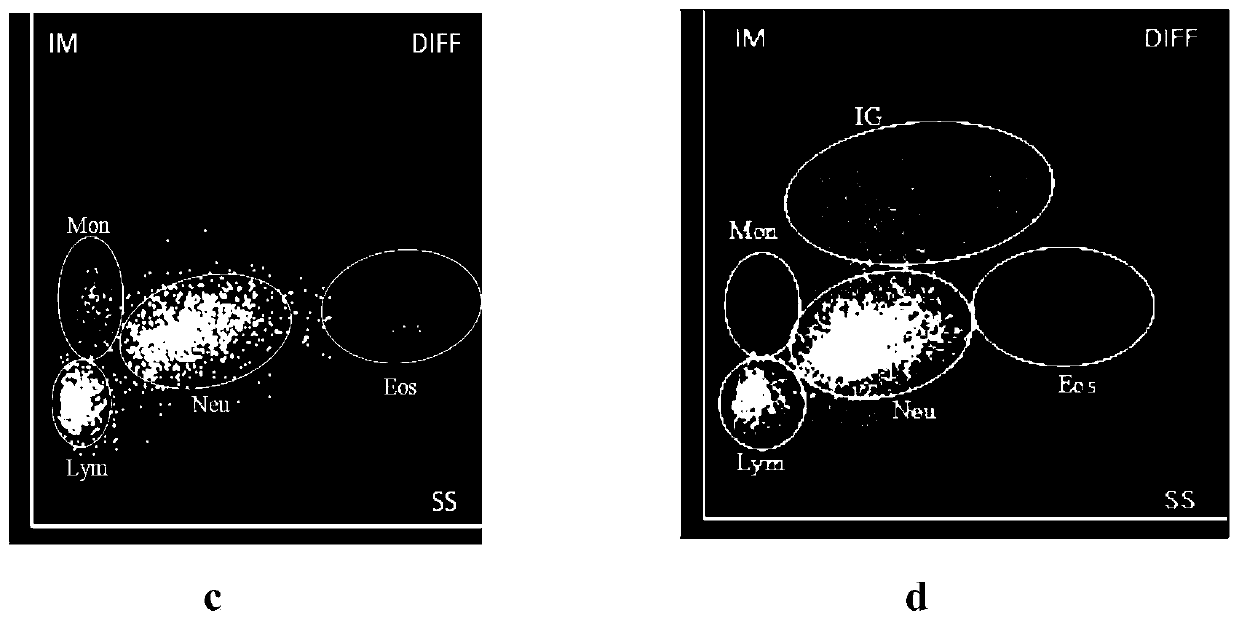Leukocyte classification reagent
A white blood cell classification and reagent technology, applied in the direction of analysis materials, individual particle analysis, biological particle analysis, etc., can solve the problems of environmental pollution, complex reagent components, etc., and achieve the effect of simple formula
- Summary
- Abstract
- Description
- Claims
- Application Information
AI Technical Summary
Problems solved by technology
Method used
Image
Examples
Embodiment 1
[0029] Embodiment 1: The leukocyte classification reagent of the present invention and its application detection
[0030]
[0031] The physical and chemical properties of the reagent prepared by the above formula were tested, the pH was 7.0, the osmotic pressure was 396mOsm / kg, and the conductivity was 18ms / cm. Use the above reagents to test blood samples a (normal sample) and b (abnormal sample - immature granulocytes) on the SC-9000 automatic blood analyzer. The results are as follows figure 1 -a and figure 1 -b shown. Neu denotes neutrophils, Lym lymphocytes, Mon monocytes, Eos eosinophils and IG immature granulocytes. White blood cells are divided into neutrophils, lymphocytes, monocytes, eosinophils (and immature white blood cells) several types, each type of cell boundaries are clear.
[0032] Preparation does not use the formulated reagent (control) formula of polyol type nonionic surfactant of the present invention as follows:
[0033]
[0034]
[0035] Th...
Embodiment 2
[0036] Embodiment 2: The leukocyte classification reagent of the present invention and its application detection
[0037]
[0038] The reagent prepared according to the above formula, the physical and chemical properties of the test reagent, pH is 5.5, osmotic pressure is 525mOsm / kg, and conductivity is 22ms / cm. Using the above reagents to test blood samples c (high eosinophilic samples) and d (abnormal samples - immature granulocytes exist) on the SC-9000 automatic blood analyzer, the results are as follows figure 2 As shown in -c and 2-d, the white blood cells on the scatter diagram are divided into four clear cell groups of lymphocytes, monocytes, neutrophils and eosinophils. In samples with immature granulocytes, immature granulocytes Also grouped individually.
[0039] Also prepare the reagent (control) according to Example 1, replace Tween-40 in the formula of this example with dodecyltrimethylammonium chloride, and use the reagent (control) to detect sample d, the ...
Embodiment 3
[0040] Embodiment 3: The leukocyte classification reagent of the present invention and its application detection
[0041]
[0042] Prepare the reagent according to the above formula, test the physical and chemical properties of the reagent, the pH is 8.0, the osmotic pressure is 685mOsm / kg, and the conductivity is 20ms / cm. Use the above reagents to test blood samples e (normal samples) and f (abnormal samples - there are immature granulocytes) on the SC-9000 automatic blood analyzer, the results are as follows image 3 As shown in -e and f, the white blood cells on the scatter diagram are divided into four clear cell groups of lymphocytes, monocytes, neutrophils and eosinophils. In the samples with immature granulocytes, the immature granulocytes are also separated In groups.
[0043] Also prepare the reagent (control) according to Example 1, replace Tween-60 in the formula of this example with dodecyltrimethylammonium chloride, and use the reagent (control) to detect samp...
PUM
 Login to View More
Login to View More Abstract
Description
Claims
Application Information
 Login to View More
Login to View More - R&D
- Intellectual Property
- Life Sciences
- Materials
- Tech Scout
- Unparalleled Data Quality
- Higher Quality Content
- 60% Fewer Hallucinations
Browse by: Latest US Patents, China's latest patents, Technical Efficacy Thesaurus, Application Domain, Technology Topic, Popular Technical Reports.
© 2025 PatSnap. All rights reserved.Legal|Privacy policy|Modern Slavery Act Transparency Statement|Sitemap|About US| Contact US: help@patsnap.com



